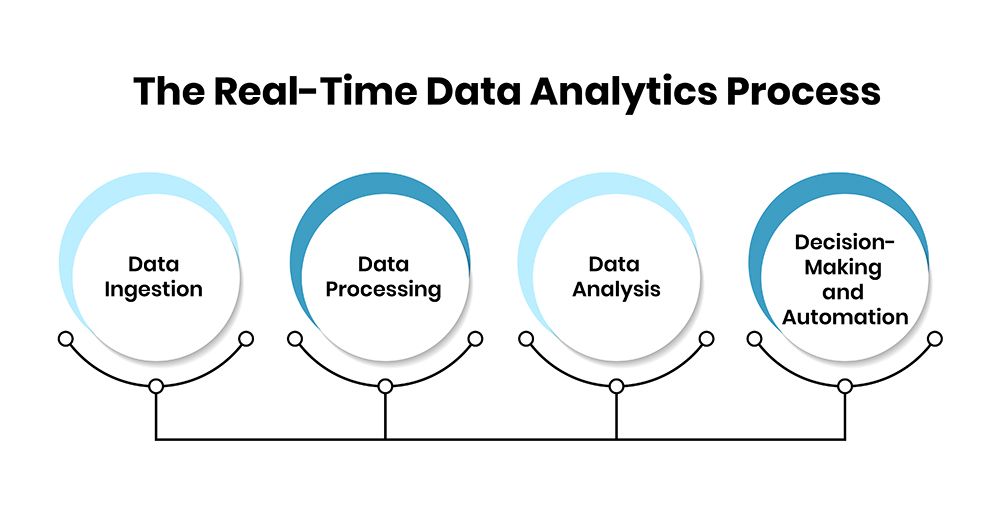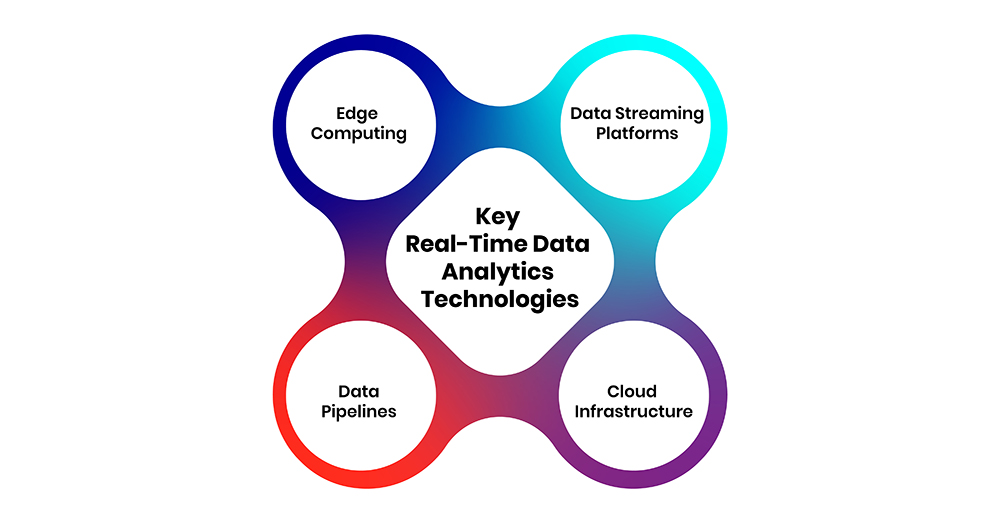
In today's ever-fast-paced, data-driven world, businesses need answers to questions immediately to make informed decisions. Data analytics in real-time allows for the processing and analysis of data on time when it is created, providing almost real-time insights to assist in decision-making. The shift from traditional delayed analytics to real-time analytics is transforming industries ranging from finance to healthcare. Comparing batch vs. real-time analytics, organizations can understand the value of real-time analytics, and how this enables more efficient and agile operations, and thus competitive advantage.
What is Real-Time Data Analytics?
Real-time data analytics is the art of analyzing data as it's generated to react in real time to insights and trends. Unlike traditional methods, which heavily rely on batch processing, real-time analytics give you immediate results, letting you make faster data-driven decisions.
The key elements of real-time data analytics include:
- Data Ingestion: Reading data in real-time from a few sources such as IoT devices, social media platforms, or transaction systems.
- Data Processing: Organizing and processing the incoming data streams to prepare them for analysis, e.g., using Apache Kafka or Amazon Kinesis.
- Analysis: Algorithms and analytical models extract meaningful insights from the floating data stream.
- Action: Leveraging the knowledge to spark immediate actions, like updating dashboards, sending alerts, or implementing automated system adjustments.
This approach is critical because real-time decision-making provides a competitive advantage. For example, it enables real-time analytics for e-commerce platforms to personalize shopping experiences immediately and for financial institutions to simultaneously identify and block fraudulent transactions. Real-time data analytics allows the ability to act on insights without delay, which is invaluable for modern businesses.
The Real-Time Data Analytics Process: A Breakdown
Real-time data analytics is a complex series of steps that allows businesses to gather and process data in real-time and act on it immediately as it arrives. The goal of this process is minimal delay, utilizing the insights at the time of decision.

-
1. Data Ingestion
The starting point is data ingestion, where data from different sources is collected in real-time. There can be IoT sensors, social media feeds, transactional systems, and even mobile devices as sources of these. They bring a continuous flow of structured or semi or unstructured data, all of which needs to be managed by a robust system. -
2. Data Processing
The data must be processed quickly after being ingested to extract helpful information, as large-scale data is handled without delays through stream processing systems. Technologies like Apache Kafka and Apache Flink make real-time data streaming and analysis possible. The idea is to do low-latency processing without sacrificing the data's accuracy.- Stream processing: It handles data as it comes in, producing real-time insights.
- Buffering: Temporarily stored data regulates continuous flow and facilitates smooth processing.
-
3. Data Analysis
Conversion of raw data to actionable insights is the heart of the real-time analytics process. Patterns, anomalies, or trends are detected instantly using machine learning models, statistical tools, or rule-based algorithms. -
4. Decision-Making and Automation
After the analysis, decisions can be automated or handed over to decision-makers. Outputs are real-time dashboards, alerts, and notifications that enable businesses to act quickly. In industries requiring real-time responses, such as finance and healthcare, it is essential to have this streamlined process to make quick and accurate decisions.
Batch vs. Real-Time Analytics: Key Differences and Use Cases
Organizations must be able to determine which form of data processing to use for their data analytics needs. In batch vs. real-time analytics, you’ll know that each methodology serves distinct purposes and has corresponding advantages and challenges.
Batch analytics refers to processing vast amounts of data in one shot, usually after it has been gathered over time. This is good when you don't immediately need insights. For instance, companies often use batch analytics for:
- Monthly sales report: Performance metrics for a fixed time to support strategic decision-making.
- Data archiving: Historical data is stored for future analysis and compliance purposes.
- Trend analysis: Patterns to evaluate long-term to drive product development.
On the contrary, real-time analytics allows an organization to process and analyze data as it is available. This is also advantageous to industries whose decisions are time-sensitive because of its capability to provide immediate insights and to make such decisions quickly. Everyday use cases for real-time analytics include:
- E-commerce: User behavior to instantaneously track and use them in your recommendations.
- Healthcare: Real-time patient data monitoring to respond to critical health changes.
- Finance: To minimize risk, identify fraudulent transactions as they take place.
In a nutshell, batch analytics has its place for a deep dive into historical data. But real-time analytics gives organizations the power to gain insights in real-time to inform better, faster, more proactive decision-making. The decision between the two is mainly determined by the particular business requirements, the type of data, plus the results that need to be achieved.
Technologies Enabling Real-Time Data Analytics
Real-time data analytics is based on advanced technologies that process large amounts of data with minimal latency. The backbone of real-time data systems comprises these technologies that deliver real-time data from ingestion to insight.

Key technologies include:
- Data Streaming Platforms: Continuous ingestion and processing of data streams is possible using tools such as Apache Kafka, Amazon Kinesis, and Apache Flink. These platforms allow businesses to act on generated data as soon as it's created by handling real-time input from different sources.
- Cloud Infrastructure: Scalable, on-demand infrastructure can be provided via cloud platforms like AWS, Microsoft Azure, and Google Cloud. This lets businesses offload their real-time data analytics heavy computational load without investing in costly on-premises solutions.
- Data Pipelines: Real-time data is flashed off and processed swiftly with tools like Apache NiFi or Google Dataflow before it gets to the hands of the end users. They are automated pipelines that allow the elimination of manual intervention and increase efficiency.
- Edge Computing: Edge computing helps reduce latency by processing data closer to the source (the 'edge' of the network), which diminishes decision-making time during IoT or autonomous vehicle applications.
These technologies work in sync to empower businesses to leverage the power of real-time data analysis.
Applications of Real-Time Data Analytics Across Industries
Real-time data analytics is transforming how businesses across enterprises of all domains work by creating fast, action-oriented insights that help companies make strategic and operational decisions. Organizations that process and analyze data as it is generated remain agile, predict trends, and react to opportunities or risks within minutes. Below are some critical industry applications:
- Retail and E-commerce: Real-time data analytics is applied by companies to find patterns, provide value, personalize the customer experience, and track purchase behavior. Retailers can dynamically adapt pricing depending on demand and competitive pricing as a result, which, of course, increases sales as well as customer satisfaction.
- Healthcare: In the healthcare industry, real-time analytics is used to monitor patients' vitals and predict future health problems, and these techniques help optimize the treatment plan. For example, wearable devices monitor patient health metrics and signal to healthcare providers when things are off and require urgent attention, all of which help improve patient outcomes.
- Finance: Fraud detection and prevention is essential in real-time analytics. Financial institutions analyze real-time transactions, looking for suspicious patterns and reducing fraud risk. It also facilitates algorithmic trading, where decisions are made in milliseconds to take advantage of market fluctuations.
- Manufacturing: Manufacturers use real-time analytics for predictive maintenance to identify equipment failures before they happen. It also reduces downtime and increases work productivity. Another application is supply chain optimization, where manufacturers can respond to demand changes simultaneously.
These industries can achieve better performance, risk management, and customer satisfaction by integrating real-time data analytics into their operations to take advantage of the long-term benefits.
Conclusion
Real-time data analytics has become the need of the hour for businesses to gain an edge over their competition. It makes quick decisions and proactive responses that help reinforce customer experience, optimize operations, and achieve innovation. Real-time insights enable companies to stay ahead of market shifts, become more efficient, and reduce costs. With increasing technology advancement, businesses will adopt real-time analytics to gain agility and remain relevant.
































